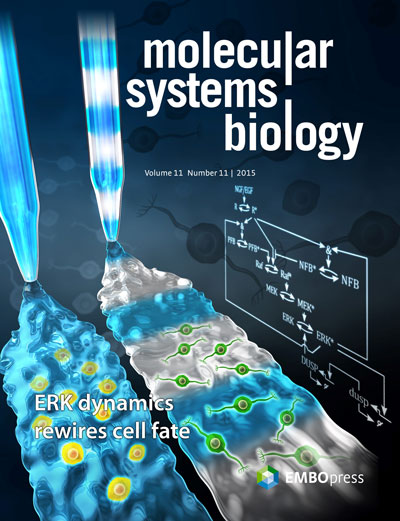A single embryo-cell develops into a fully functional organism that consists of dozens of different cell types. This process of development involves cells growing, dividing and then specializing (differentiating), for example by turning into a neuron – a building block of our nervous system. Understanding the mechanisms that lead to eventual fate of the cell significantly increases the breadth of clinical interventions in cases when these mechanisms go awry, such as in cancer or abnormal foetal development. The ability to predict the outcome of cell differentiation supports regenerative approaches to neurological diseases in which stem cells are nudged towards the desired fate to circumvent the loss of damaged cells.

Cover of Molecular Systems Biology (2015 Nov; 11(11)) that features the paper from Ryu et al.
The study of differentiation and proliferation under laboratory conditions often relies on so-called PC12 cells. For over two decades it has been known that PC12 cells proliferate when treated with the hormone EGF, but differentiate when treated with another hormone, NGF (Marshall, 1995). But new research reveals that the story is not as clear cut. HFSP Program Grant awardees Olivier Pertz (University of Basel) and Noo Li Jeon (Seoul National University), together with mathematical modellers at Systems Biology Ireland, have now shown that the PC12 cells can differentiate even in response to EGF, the growth factor typically used to stimulate cell proliferation.
Earlier experiments were restricted to a constant treatment and could only measure the average behaviour of many thousands of cells. In contrast, the Pertz lab was able to follow responses of hundreds of individual cells treated with hormones delivered in a sequence at different intervals. This was possible thanks to the Jeon lab that manufactured ingenious microfluidic devices programmable to any sequence of pulses. The results revealed that individual cells behave strikingly differently, but also that they can be harmonised to reach the same endpoint – differentiation – by applying a specific pulsing pattern.
The rationale behind the correct pulsing pattern came from understanding the dynamics of biochemical reactions that control the balance between cell proliferation and differentiation. The reactions form a connected network that could be understood with a mathematical model. The model predicted a way to drive cells towards differentiation regardless of which hormone was applied. The key finding that enabled cell differentiation in the presence of EGF was to deliver it repeatedly in, for example, a 3-minute EGF pulse followed by a 20-minute break.
The research highlights the importance of interdisciplinary research where high quality experimental data enable development of predictive mathematical models, which in turn help to reveal salient features of the living system and to suggest experiments with interesting outcomes.
Commenting on the research, Nils Bluethgen, Professor of Computational Modelling in Medicine at the Charite University Hospital in Berlin, reminds us that the idea to challenge networks with very defined input patterns is comparable to how engineers would probe an electrical circuit (Bluethgen, 2015). "The arena is open to use these approaches to unravel how different network features like feedbacks and feed‐forward loops in signalling interact to encode specific signals," says Prof. Bluethgen.
Reference
Frequency modulation of ERK activation dynamics rewires cell fate. Hyunryul Ryu, Minhwan Chung, Maciej Dobrzyński, Dirk Fey, Yannick Blum, Sung Sik Lee, Matthias Peter, Boris N Kholodenko, Noo Li Jeon, Olivier Pertz. DOI 10.15252/msb.20156458. Published online 27.11.2015. Molecular Systems Biology (2015) 11: 838.
Other references
[1] Specificity of receptor tyrosine kinase signaling: transient versus sustained extracellular signal‐regulated kinase activation. Marshall CJ. (1995) Cell 80: 179–185.
[2] Signaling output: it's all about timing and feedbacks. Blüthgen N. (2015) Mol Syst Biol. 2015 Nov 27;11(11):843.


































